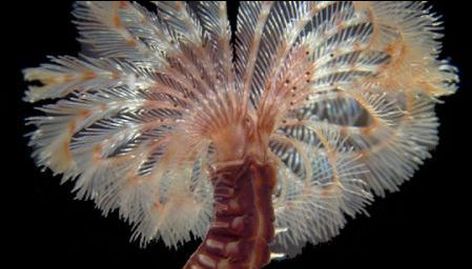Biodiversity of polychaete worms
Biodiversity of polychaete worms (Annelida)
Polychaete worms (annelids) are among the dominant organism groups in sediments on the seabed. Almost 800 species are known from Norwegian waters, and many are undiscovered. The main goal of our project is to contribute to new knowledge of biological diversity of polychaetes from the coast to the deep sea. Taxonomic challenges, species with unclear status in terms of name use and identity are studied using morphological identification and description, and DNA-based methods. Species distribution and mechanisms for this are important elements in new knowledge.
 Pseudopotamilla sp. Photo: Sabine Cochrane
Pseudopotamilla sp. Photo: Sabine Cochrane
We are constantly discovering new species. Data show that 15-25% of polychaetes in Norway are unknown or have unclear taxonomic status. In particular, we see that the continental slope has a rich diversity that has previously been overlooked. Here, species that have their main distribution on the continental shelf meet species that are mainly found in the deep-sea in the Norwegian Sea.
Important goals are to contribute new knowledge of poorly known species or species groups. Identity of species, the difference between them, species delimitation, evolutionary relationships are topics that are highlighted. This also provides a basis for studying the distribution of species. DNA barcoding is an important element, an activity we do through the Norwegian Barcode of Life (NorBOL). This helps to document diversity and cryptic species. In addition, this contributes building a library with DNA barcode for polychaetes from Norwegian waters.
The scientific collections at the university museums are important. Here we find material collected over more than 150 years. Together with specimens collected from small and large projects over time, today's collections are a rich source of new knowledge. Collecting new samples is also used strategically to build the scientific collections. Fieldwork is important for gaining new knowledge. In addition to our own activities, projects supported by the Norwegian Biodiversity Centre and the interdisciplinary program for mapping the seabed through MAREANO (Marine AREAl database for Norwegian waters) are important for the supply of material.
The research has an international foundation in collaboration with colleagues around the world, preferably about specific species groups and their systematics.
Project Status: Active
Collaborators
- Eivind Oug, Norwegian Institute for Water Research (NIVA)
- Jon Anders Kongsrud, University Museum of Bergen, University of Bergen
- Tom Alvestad, University Museum of Bergen, University of Bergen
- Nataliya Budaeva, University Museum of Bergen, University of Bergen
- Maria Capa, University of Balearic Islands, Spain
- Arne Nygren, University of Gothenburg, Sverige
- Robin Wilson, Museums Victoria, Australia
- Chris Glasby, Museum and Art Gallery of the Northern Territory, Australia
- Cinthya Santos, Universidade Federal Fluminense, Brazil
- Carol Simon, Stellenbosch University, South Africa